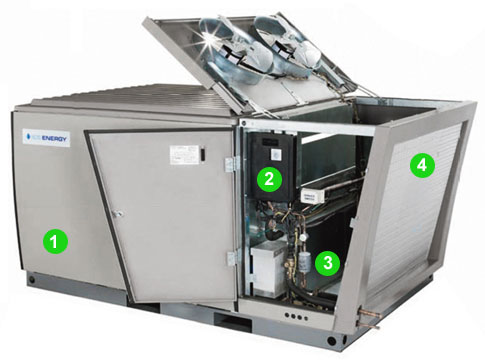Chill Factor
Storage of renewable energy
A significant fraction of the nation's wind power is produced at night, during off-peak periods. In western Texas, for example, 12 percent of the wind power produced in 2009 was generated during periods when the wholesale price of electricity was worth nothing, because there was no demand for it, and less than a quarter of the wind output corresponds with peak demand. This disconnect between availability and demand will become a bigger problem as wind power becomes a larger contributor to the nation's power supply. TES offers a great way to use renewable electricity produced at night (making ice) to satisfy peak loads (daytime cooling). Another way to look at this is that as more wind capacity is installed, off-peak power will get cheaper (and cleaner), making TES a better and better option. The same arguments will hold true if wave power becomes a significant renewable energy source.
Counting the points
In the design and construction versions of the LEED Rating System, energy optimi-zation points are tied to the ASHRAE/IESNA 90.1 Standard, which calculates savings based on energy cost. In those rating systems, thermal energy storage installations that save on energy costs will also garner energy points. In LEED for Existing Buildings: Operations and Maintenance (LEED-EBOM), however, energy points are linked to federal ENERGY STAR index, which measures units of actual energy-kilowatt hours of electricity and therms of natural gas-as opposed to energy cost. Under the ENERGY STAR system thermal storage doesn't fare as well, because it doesn't necessarily reduce overall energy use. In fact, in some cases it even increases it, due to the losses that happen each time energy is transferred from one medium to another. (Ice storage systems may be eligible for an innovation credit under LEED-EBOM, according to MacCracken, but this is not assured.)
Thermal Energy Storage without Chillers |
Until recently, ice-based TES systems were only available for large buildings with chiller-based cooling. Since the 1980s, thousands of these systems have been installed in a wide range of commercial, institutional, and industrial buildings.According to Commercial Building Energy Consumption Survey (CBECS) data published by the U.S. Department of Energy, chillers provide cooling for 72.6 percent of commercial-building square footage in the U.S. Chillers are also generally used for district-cooling systems that provide cooling for 11 percent of U.S. commercial-building square footage-and TES supports most district cooling. But, until recently, TES was not suited to the 12.5 percent of commercial-building square footage that is cooled using packaged, direct-expansion cooling. This may sound like a small segment of the market, but that 12.5 percent of commercial-building space actually accounts for 95 percent of the nation's commercial buildings (because most commercial buildings are relatively small). Most of these are too small to justify chillers, though the number also includes many big-box retail stores and factories that are cooled with dozens or even hundreds of rooftop packaged air conditioners. In 2003, the Colorado company Ice Energy made TES applicable to these smaller buildings. Instead of producing chilled water for cooling a building, Ice Energy's Ice Bear chills refrigerant that directly expands in the evaporator component of an air conditioner to cool the air. -A.W.  |
Ice Energy's Ice Bear unit incorporates
into a building's standard AC system |
Â
Looking ahead
Ice-based thermal energy storage systems save building owners money by shifting cooling energy use to off-peak periods, reducing peak demand, and (with new construction) reducing first-costs. As the nation's utility grid is modernized and a "smart grid" emerges, TES will become even more important as an energy-management strategy.
Given these benefits of TES, it is indeed surprising that the practice is not more widely used. Even in green building, TES is uncommon. There are huge opportunities in the commercial-building sector that continue to be missed-often because advantages of TES are not well understood. As better tracking and reporting of energy performance becomes common, and as new utility pricing structures incentivize load-shifting, it is likely that thermal energy storage will finally gain the place it deserves in our palette of HVAC options.
FOR MORE INFORMATION: |
"Thermal Energy Storage for Space Cooling,"
December 2000 "Cool Storage Technology Guide," August 2000 Heating, Ventilating, and Air-Conditioning
Systems and Equipment, 2008 (Chapter 50) Space Cooling Technology Atlas, 1998 |








